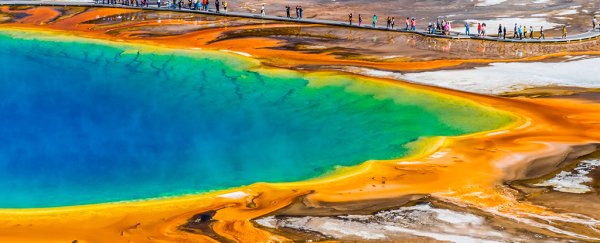Yellowstone National Park's supervolcano could be the result of rubbing tectonic plates after all, a new study suggest – challenging the favoured explanation which pins it on heat billowing up from deep beneath the crust.
Virginia Tech geoscientist Ying Zhou has identified anomalies in the crust that suggest sliding layers of rock are responsible for generating the enormous amount of heat, not a magma plume as was previously thought. This study might not settle the argument, but it does show the debate is far from over.
If there's one thing Wyoming's Yellowstone is famous for around the world – other than its pristine natural beauty – it's the churning belly of magma that could one day burst free in a catastrophic eruption.
But there's an ongoing debate over which geological forces are primarily responsible for the region's volcanic basement.
In one corner, there's the magma plume model, which blames a channel of molten rock rising from the mantle through a rift or weakening in the crust for the hot mess beneath the surface.
In the other, there's the subduction explanation. Huge chunks of Earth's crust slide over one another, creating the enormous amounts of rock-melting friction needed to fill Yellowstone's magma chambers.
Naturally, volcanoes that sit near the edge of tectonic plates – like those in Indonesia – are assumed to be powered by the rubbing-rocks model. For others, such as Hawaii's chain of volcanic islands, the magma plume model is a safer bet.
Yellowstone has all the hallmarks of a volcano produced by a hotspot of rising magma, sitting at the end of a dotted line of calderas – the sunken hollows that form after the eruption of a magma chamber.
These calderas hint at a stuttering history of eruptions as the crust slowly drifted across the plume.
Not to mention the fact that the state of Wyoming sits somewhere in the middle of the North American tectonic plate, far from where you might imagine bumping bits of crust might be a problem.
There's just one problem – nobody could find direct evidence of an actual magma plume stretching up from the mantle.
Earlier this year, a researcher from the University of Texas used seismic waves from earthquakes to describe a 3,000 kilometre (1,900 mile) column of hot rock that just might fit the bill.
But not everybody is convinced, and the debate continues over whether scientists have been too quick to dismiss other models.
Zhou also used seismic activity to sketch out a picture of what might be lurking under deep beneath Yellowstone. Applying a technique called diffraction tomography, she mapped out the discontinuities in the crust.
"This is the first time the new imaging theory has been applied to this type of seismic data, which allowed us to see anomalous structures in the Earth's mantle that would otherwise not be resolvable using traditional methods," says Zhou.
There was no sign of any plume. Instead, these anomalies followed the path of calderas. The waves also described a pattern that roughly followed the shape of an ancient, buried slab of oceanic crust called the Farallon Plate.
This dense rock started its journey beneath the North American Plate way back when the supercontinent of Pangaea began to break apart, roughly 175 million years ago.
Some bits of this ancient plate remain, bumping and grinding under the US like geological flotsam beneath the hull of an enormous boat.
"This ancient oceanic plate broke into pieces, resulting in perturbations of unusual rocks in the mantle which led to volcanic eruptions in the past 16 million years," says Zhou.
The whole process kicked off near what's now the border between Oregon and Idaho, with heat from the sunken Farallon Plate rubbing against the North American Plate causing magma to rise into a series of weak points in the crust.
Yellowstone is simply the latest point on the map to feel the heat from Farallon's ongoing journey.
The idea that the remains of the Farallon plate could be behind Yellowstone's volcanism isn't new. In fact, another study published earlier this year used computer simulations to show how the model is a perfect fit.
It's unlikely that Zhou's study will be a knock-out punch for the plume model. But she intends to find more evidence by increasing the resolution of her scans.
"More detailed images of the unusual rocks in the deep earth will allow us to use computer simulation to recreate the fragmentation of the gigantic oceanic plate and test different scenarios of how rock melting and magma feeding system work for the Yellowstone volcanoes," says Zhou.
This research was published in Nature Geoscience.
